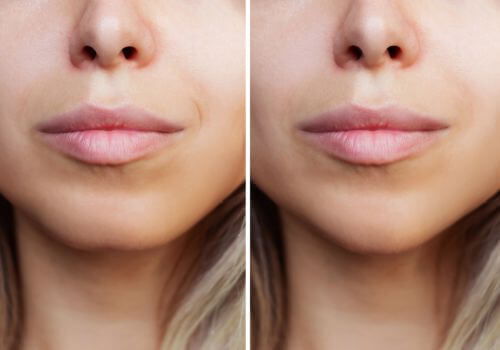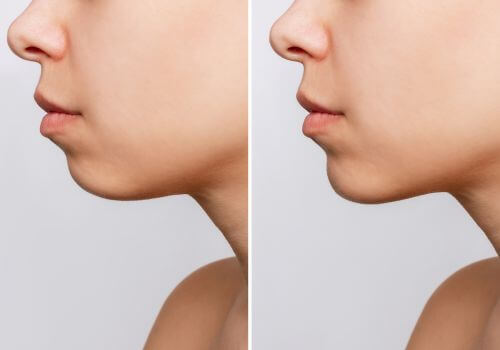Chin shape and proportion play significant roles in facial harmony and balance. If you are unhappy with your chin’s appearance, sliding genioplasty is a surgical solution that provides dramatic improvement. This advanced procedure reshapes the chin by precisely cutting and repositioning the bone, providing a natural-looking result that enhances overall facial aesthetics. As dental professionals, we are here to help you determine whether this procedure could be right for you.
What Is Sliding Genioplasty?
Sliding genioplasty is a surgical procedure that modifies chin shape and projection by cutting the chin bone, moving it forward or backward, and securing it in a new position. Unlike chin implants, this procedure works with your existing bone structure, allowing for a completely natural result.
Sliding genioplasty addresses several chin concerns, including:
- Recessed (weak) chins
- Overly projected chins
- Asymmetrical chins
- Chin height issues
- Chin width concerns
As dental professionals, we recommend sliding genioplasty when patients need significant chin repositioning or complex three-dimensional changes that implants cannot achieve.
How Does Sliding Genioplasty Compare to Other Chin Procedures?
Sliding genioplasty differs from other chin enhancement options in several ways. While chin implants add volume to the existing structure, genioplasty actually changes the bone.
Surgeons can place chin implants quickly, and they require minimal recovery time. However, they carry risks of shifting, infection, and an artificial appearance. They also cannot correct functional issues or provide the same degree of customization as genioplasty procedures.
Fillers offer temporary, non-surgical chin enhancement but require regular maintenance and provide limited projection improvement. The results last 6-18 months, depending on the product used and the patient’s metabolism.
The Surgical Procedure
During sliding genioplasty, the surgeon makes an incision inside the patient’s mouth between the gum and lower lip. This approach prevents visible external scarring and allows direct access to the chin bone.
The surgeon then cuts through the chin bone and carefully slides the bone segment to its new position. Depending on the patient’s needs, the bone might move forward, backward, up, down, or be reshaped to address width concerns.
Once positioned correctly, the surgeon secures the bone segment with titanium plates and screws. These fixation materials generally remain permanently in place and won’t set off metal detectors or interfere with MRIs.
Finally, the surgeon closes the incision using dissolvable sutures and may apply a compression garment to reduce swelling. The entire procedure takes 1-2 hours under general anesthesia.
Benefits of Sliding Genioplasty
Sliding genioplasty offers numerous advantages over other chin enhancement methods. Its versatility allows surgeons to increase or decrease chin projection, height, and width according to individual needs. The results are permanent and won’t degrade over time, eliminating the need for repeated treatments.
The procedure uses your own bone tissue, so the results look and feel natural because they are natural. And since no artificial materials are used, there’s no risk of implant-related complications such as shifting, exposure, or rejection.
For patients with aesthetic and functional concerns, sliding genioplasty addresses both simultaneously. The procedure significantly changes facial balance, often dramatically improving the face’s overall appearance. Each surgery is customized to the individual’s facial proportions to ensure harmonious results.
What to Expect During Recovery
Swelling, pain, and discomfort are common in the first 1-3 days following surgery. Most patients spend a night or two in the hospital or surgical center and receive medication to control pain. During this period, you will be on a liquid or soft food diet.
During early recovery (1-2 weeks), swelling gradually starts to subside. Patients can usually return to desk work or school after 7-10 days, though speech may be temporarily affected. To allow for proper healing, you will need to continue a soft food diet.
Most visible swelling resolves in the intermediate recovery phase (2-6 weeks after surgery), though some residual swelling may remain. Patients can resume normal activities, including light exercise, after 3-4 weeks. Avoid more strenuous activities until cleared by your surgeon.
During long-term recovery (6 weeks - 6 months), swelling fully resolves. The bone fully heals, and the final results become apparent. Patients typically report high satisfaction rates once healing is complete.

Recovery Tips and Considerations
Follow your surgeon's instructions carefully to ensure optimal healing after sliding genioplasty. Most recommend a soft diet for at least 2-3 weeks to avoid putting pressure on the healing bone. Take all prescribed medications, including antibiotics, as directed to prevent complications and minimize pain. Attending all follow-up appointments allows your surgeon to monitor your healing progress and address concerns.
Applying cold compresses as directed during the first 48-72 hours can significantly reduce swelling, and sleeping with your head elevated for the first week eases discomfort.
Proper oral hygiene becomes especially important after this procedure. Your surgeon will provide specific instructions, which might include using a special mouthwash and using extreme care when brushing around the surgical area.
Smoking and tobacco products impair healing and increase complication risks, so avoiding them is crucial. Lastly, stay hydrated and maintain good nutrition to support your body’s natural healing processes.
Potential Risks and Complications
While sliding genioplasty is generally safe when performed by qualified surgeons, no surgery is without risk.
- General surgical risks include infection, adverse reactions to anesthesia, bleeding, and poor wound healing.
- Some genioplasty patients experience lower lip or chin numbness due to nerve stretching or damage during surgery. This numbness typically improves over 3-6 months but may be permanent in rare cases.
- Potential aesthetic complications include asymmetry, over or under-correction, and bone resorption affecting the final appearance. Choosing an experienced surgeon minimizes these risks.
- Functional issues, such as bite alignment changes, can occur but are rare with proper planning. A thorough pre-surgical assessment helps prevent these complications.
The Consultation Process
A thorough pre-surgical consultation includes several components. The surgeon will perform a facial analysis, examining your facial proportions, chin position, and overall balance to determine what changes would create the most harmonious result.
Your surgical team will review your medical history thoroughly to ensure you’re a safe candidate for surgery. This includes discussing previous surgeries, medical conditions, allergies, and medications.
Imaging studies, like X-rays, CT scans, and sometimes 3D imaging, help plan the precise bone movements needed for optimal results. Many surgeons also use computer simulation to show potential results, giving you a clearer picture of what to expect.
The consultation also includes a detailed discussion of expectations, ensuring clear communication about realistic outcomes. This prevents disappointment while helping you make an informed decision about proceeding with surgery.
Cost Considerations
Sliding genioplasty typically costs between $5,000 and $10,000, depending on the surgeon’s experience, geographic location, and individual case complexity. The price includes the surgeon’s fee, anesthesia costs, facility fees, and immediate post-operative care.
Insurance rarely covers this procedure when performed for purely cosmetic reasons but may provide coverage when functional issues exist. Some practices offer financing options to make genioplasty more accessible.
When comparing costs between surgeons, make sure you understand exactly what’s included in the quoted price to avoid unexpected expenses. Also, remember that the cheapest option isn’t always the best value — especially when considering the permanent nature of the results.
Closing Thoughts
Sliding genioplasty is a powerful, permanent solution for improving chin appearance and facial balance. The procedure provides natural-looking results because it works with your existing anatomy rather than adding artificial materials.
While recovery requires patience, most patients find the long-term benefits well worth the temporary discomfort. With proper surgical planning and post-operative care, sliding genioplasty can dramatically enhance facial harmony and boost confidence.
The first step toward achieving your aesthetic goals is consulting with a qualified surgeon about whether sliding genioplasty is right for you. Schedule your appointment with us to get started!





